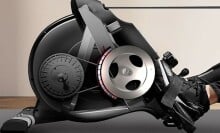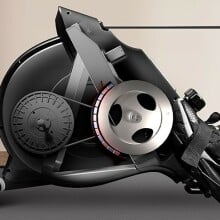While many people have turned to treadmills and free weights to build out their home gyms, these options aren't always the most joint-friendly. If your ankles and knees ache just thinking about running, rowing just might be the low-impact-yet-cardio-intensive workout you need. Not only will a rowing workout get your heart pumping and increase your endurance, but it'll also help you build muscles in your arms, legs, back, butt, and core. Total win-win.
Read on for answers to all your rowing-related questions and to take a peek at the best models available online.
So what exactly is a rowing machine?
Simply put, a rowing machine mimics the effects of rowing on the water by using different types of resistance. When it comes to rower resistance, there are four types to consider: air, magnetic, water, and hydraulic. While each type of rower exercises the same muscle groups, there are a few major differences to consider before making a purchase.
Air resistance rowing machines
Air resistance rowers use a flywheel to generate air resistance as you pull your body. So the harder and faster you pull, the harder the resistance or “drag” becomes. This creates a workout that mimics the sensation of rowing on the open water. Air rowers are favored by Olympians and professional athletes alike. So if you’re looking to go pro — or at least train like a pro — an air rower is your best bet.
Magnetic resistance rowing machines
With a magnetic rower, the user sets the desired resistance by moving a magnet closer or farther away from the flywheel. Magnetic resistance rowers tend to be quieter than air resistance rowers, so if you live with roommates or in an apartment with shared walls, a magnetic resistance rower may be a better fit.
Water-resistance rowing machines
Water rowing machines use water resistance to create what some say is the smoothest stroke. These rowers feature a large round water tank at the front of the machine, and they create a pleasant sound while in use that makes you feel like you're actually on the water. There aren't any manual resistance settings on water rowers, so if you want a harder workout, you'll have to either row faster or add more water to the tank. The level of water in the tank is controlled by the user and represents the weight of the boat and its captain. If you want a heavier boat, you add more water to the tank. If you want a lighter boat, you remove some water from the tank. Normally, water rowers have the most basic type of monitors, but there are a few on the market now that will give you the studio class experience.
Hydraulic resistance rowing machines
The hydraulic resistance rowing machine is the most basic of rowers. Hydraulic rowers get their name from the very system that makes them run: a hydraulic cylinder. These machines rely on a cylinder filled with oil or air that a piston runs through. Resistance is created when the piston, which has an attachment connecting it to the arms of the rowers, moves in and out of the cylinder as you row. The great thing about hydraulic rowers is that they’re usually on the cheaper end of the spectrum. They also tend to be smaller machines, typically weighing no more than 60 pounds with a length of no more than 5 feet — perfect for apartments or shared spaces.
If you’re a bigger person, a hydraulic rower won’t typically allow you to fully extend. However, hydraulic rowers offer more flexibility when it comes to the arms of the machine. So if giving your arms range of motion is important to you, a hydraulic machine may be your best bet.
What type of monitor do I need?
The type of monitor you’ll need depends on the type of workout you want. Do you want to be rolling on the virtual river with a community of athletes? Do you like guidance from a fitness instructor? Or are you more of a lone rower who prefers a solitary session sans technology?
The monitors on magnetic rowers typically offer more options than those on-air rowers. Similar to a treadmill or an elliptical, you can choose from a variety of preset workouts. This is a great feature for anyone who doesn’t want to think too hard about their workout. There are also plenty of options now that include large, high-tech monitors with live and on-demand classes. So yeah, you can get a Peloton-like experience on a rowing machine.
Regardless of the type of machine you chose, even the most basic monitor will include preset HIIT (high-intensity interval training) workouts that will have you engaging not only the muscles in your arms but in your legs, back, and core too. They'll also show you a set of basic stats like heart rate, strokes, and distance.
Can you get in shape just by rowing?
Rowing uses almost every muscle in your body and can seriously kick up your heart rate, meaning you'll get a total body workout every time you hop on the rowing machine. A rowing workout targets your arms, legs, back, butt and core. It's an all-in-one type of workout machine that can integrate into any fitness routine. Just consult YouTube first to make sure you've got the proper form if you're a newbie — your workout won't do much for you if you aren't doing it correctly.
Which rowing machine is the best?
As with any major equipment purchasing decision, there are several factors to take into consideration, including resistance, price point, smart features, and size. We’ve done most of the work for you (you can thank us later), so we can get you off the internet and onto your rower in no time. Whether you’re just starting out or looking to take your workout up a notch, read on to discover the top rowers on the market based on both user and expert reviews.



























